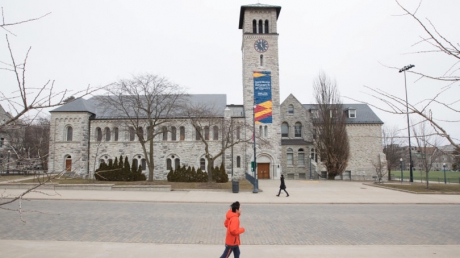Reports
You are here
As universities reopen in fall, we must fight for worker safety

July 9, 2021
Across Ontario, virtually all universities have announced their decision to return to onsite education starting fall semester. However, in most places there is no gradual or gradated return plan, and the idea is for a sudden and nearly complete return to campus. This inexplicable urge to fully return to onsite work is driven solely by profit motives – to fill student residences to capacity (read: housing income), to ensure enrolments rates are high (read: tuition income), and to make profits from on-campus rentals. Regardless of current predictions that physical distancing requirements could be lifted by fall, if this return plan is executed without sufficient and necessary protections for workers and students, University campuses will be the site of new outbreaks in September. We have already seen how poorly executed re-openings of student residences earlier this year resulted in outbreaks at many campuses.
Many workers, depending on their current places and countries of residence, will not have received both doses of vaccination at the beginning of onsite education. As things stand, unvaccinated and partially vaccinated people remain highly vulnerable to the Delta Variant, which is likely to be the dominant strain in Ontario.
From custodial staff to precarious teaching employees, a safe return to work is one of the largest concerns in the sector currently, and we must fight together.
Who is at risk? Workers, not bosses.
Once students come back to classrooms in large numbers and if onsite operations start without sufficient precautions, custodial staff, precarious teaching staff, laboratory workers and students themselves will remain highly vulnerable to workplace infections. How are Universities limiting class-room sizes? Will there be an immediate and comprehensive paid sick days plan for temporary and non-union workers? What vaccination options and facilities will be in place before we are required to be in contact with students and each other? Will Universities commit to hiring additional custodial staff so that their workloads become manageable? For employees who may be able to deliver their work remotely, shouldn’t we retain that option until the pandemic is declared over?
From what I have seen, no sufficient assurances are in place for any of these questions in the sector. At least nothing in writing. What is currently being proposed is insufficient, unconvincing, and uncomprehensive.
On the other side of things, upper administration continues to have secure, personal office spaces, infinite paid sick days, and flexible employment duties that don’t put them at physical risk. At the very top, Board Members will meet each other once a term (if that) in their luxurious COVID bubbles, and their lives will remain pretty much the same, but with newer investment options.
What can unions do?
It is crucial that we keep our ranks safe and protected through this process, and this means taking care of our most vulnerable, empowering each other and ensuring the s
afety of temporary/contract workers and migrant workers.
Unionized workers who have access to paid sick leave and other protections, must demand the same for temporary and contract workers at the University. We must be in touch with workers at cafeterias and other leased out franchisees on campus, and pressure our employer to meet their safety needs. As things stand, most temporary workers employed through third party contractors do not have comprehensive paid sick leave benefits and are yet to have the organizational power to fight for it themselves.
Similarly, migrant workers, especially international graduate student-workers, come from countries with differential access to vaccination.
Western neo-colonialism and disaster capitalism have resulted in severe vaccine shortages across the Global South, including in South Asian countries which constitute a large portion of international enrolments at Canadian Universities. As the Universities are yet to ascertain whether they will run consistent and available vaccine clinics prior to workers’ return to work, it is crucial that we protect unvaccinated or partially vaccinated migrant workers from entering an unsafe workplace.
Campus Coalition to Build Power Locally
Over the pandemic, Universities across the country have systematically eroded and fractured the decision-making powers of Joint Health and Safety Committees (JHSCs) using public health emergency as an excuse. Bargaining units have been excluded from direct conversations on COVID-19 and do not find a seat at designated committees on COVID response plans. We have instead become recipients of final or penultimate plans that we can largely symbolically review. Yet, needless to say, workers are the ones most impacted by those plans and should therefore have played an active role in the crafting of its terms. If we do not fight back against this erosion of worker power, it can have long term consequences to the very structure of decision-making in campuses.
Like all our fights, we must find connections between all units at our workplaces and develop a coalition that responds actively to the return to work proposal. While working to reclaim power to JHSCs, we must speak with one another to ensure that that our demands are unified and in one voice. From temporary workers to faculties, workers run the university and all reopening plans are banked upon our willingness to work. We must build a collective plan of education and action alongside each other, one that foregrounds the safety of the most vulnerable and brings together temporary workers, custodial staff, lower administration workers, faculties, graduate students, and all other workers at the university. By doing so, we are not only protecting ourselves and students, but our communities too.
Section:










